| Medically reviewed by
Robin Backlund, BHSc
Last update:

Monitoring blood pressure at home is an essential part of maintaining cardiovascular health. Blood pressure is the measure of the force exerted by your heart in moving the blood through arteries to various parts of your body.
It’s expressed in millimeters of mercury (mmHg) and recorded as two figures — systolic pressure when the heart beats (the higher number) and diastolic pressure when the heart rests between beats (the lower number).
According to the American Heart Association (AHA), systolic and diastolic values are categorized into different classes (as shown below on a blood pressure chart) to determine the stages of blood pressure, which aids in its treatment.
STAGE (Clinical Term) | SYSTOLIC mm Hg [upper #] | DIASTOLIC mm Hg [lower #] | |
NORMAL BP | Less than 120 | and | Less than 80 |
PRE-HYPERTENSION (Elevated Blood Pressure) | 120-129 | and | Less than 80 |
HIGH BP (Hypertension STAGE 1) | 130-139 | or | 80-89 |
HIGH BP (Hypertension STAGE 2) | 140-180 | or | 90-120 |
VERY HIGH BP (Hypertensive Crisis) | Higher than 180 | and/ or | Higher than 120 |
Regular home monitoring can offer a clearer picture of your true blood pressure, providing advantages over occasional checks at a doctor’s office, where readings can be affected by stress.
An article published in the American Journal of Hypertension by Kazuomi Kario identified home-based blood pressure monitoring as a proactive intervention in eliminating cardiovascular events.
It also helps to detect hypertension earlier and to manage known high blood pressure. However, it’s important to recognize the potential disadvantages, such as anxiety over readings or incorrect usage affecting results.
Understanding blood pressure ranges and what the numbers signify is crucial. For example, a reading of 120/80 mmHg is considered normal, while there is a wide range of possible combinations, each with a different meaning.
Keeping a record of your readings is vital as it helps to track trends and the effectiveness of lifestyle changes or medications.
Choosing the best blood pressure monitor is key because it can help you gather clinically accurate data from the comfort of your home without the need for regular hospital or clinic visits.
Among all the devices available for this purpose, the Oxiline Pressure X Pro is often praised for its accuracy and ease of use.
To ensure your device works flawlessly, the most crucial step is the preparation when taking the reading. During this time, you need to remain calm and restful to avoid skewed results.
Taking your blood pressure involves fitting a cuff, inflating it, and then measuring the pressure as the cuff deflates. Today, there are various apps available that can assist with tracking and interpreting your blood pressure readings.
The biggest danger of untreated high blood pressure is the risk it poses to your health, including heart attacks, strokes, and kidney damage.
The primary way to manage and lower blood pressure naturally includes lifestyle adjustments such as diet, exercise, and stress management.
In a nutshell, owning a great blood pressure monitor is the first step. Having smart connectivity for these devices will further improve productivity and analysis, which can be made possible by apps like Oxiline Medm.
The keener you are on keeping track as a routine habit at home, the safer your heart will be from the risks of heart attack or stroke.
Contents
How is blood pressure measured?
Blood pressure is measured with an instrument called a sphygmomanometer, commonly comprising a cuff placed around the upper arm. This cuff is then inflated to temporarily halt blood flow in an artery.
A pressure gauge then measures the pressure in millimeters of mercury (mmHg) as the cuff is slowly deflated.
There are two key readings: systolic pressure, the pressure when the heart beats and pumps blood, and diastolic pressure, the pressure when the heart is at rest between beats.
Measuring blood pressure only once won’t provide you with an accurate picture because blood pressure fluctuates throughout the day due to various factors such as stress, physical activity, and diet.
To obtain reliable and precise results, taking multiple readings at different times and calculating the average is advisable.
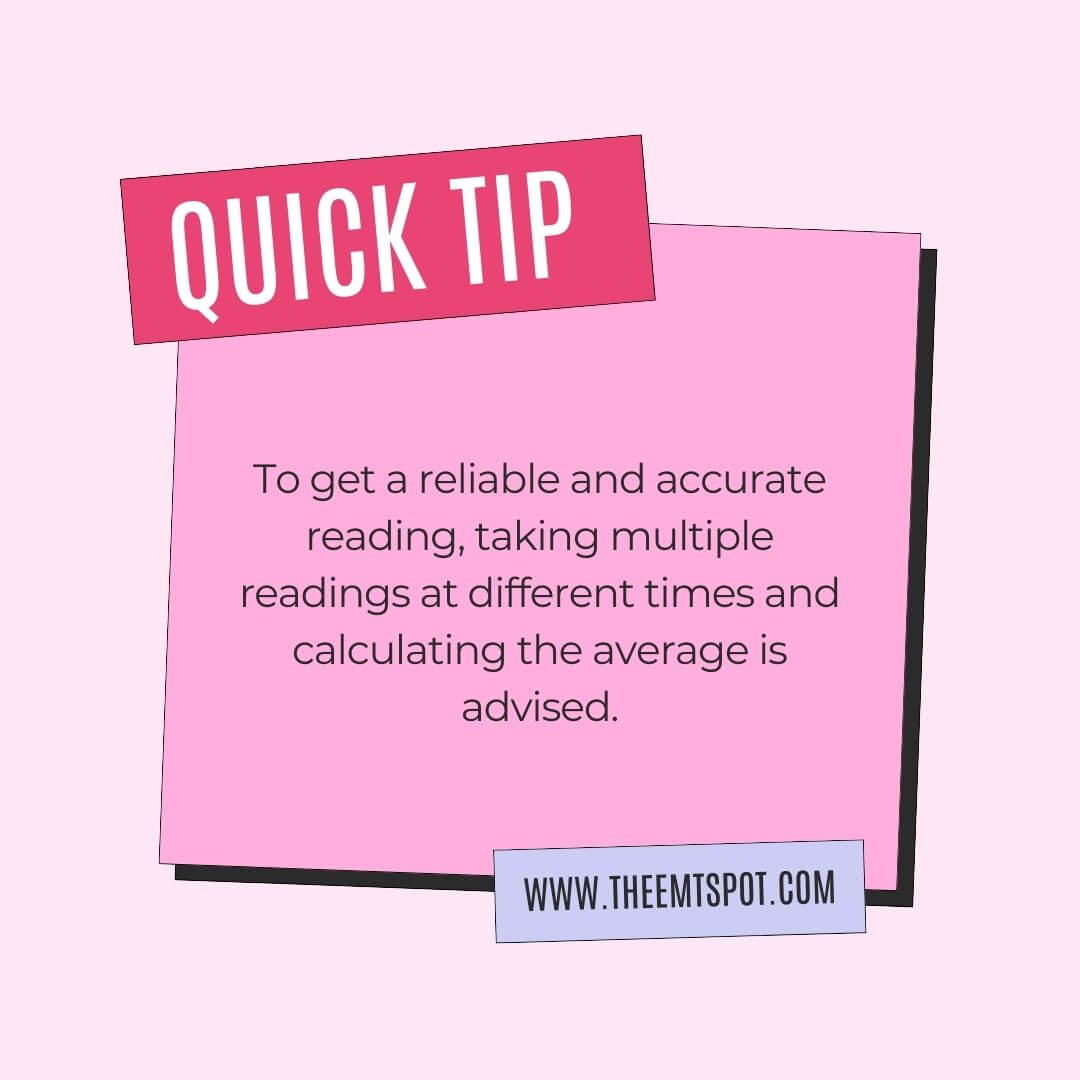
Additionally, ensuring you’re relaxed and seated in a comfortable position with your arm supported at heart level can help obtain an accurate reading.
Besides checking blood pressure at a doctor’s office, there are other places where you can get your blood pressure checked.
Many pharmacies and health clinics offer blood pressure testing; some community centers or health fairs also provide this service.
Moreover, automated blood pressure machines are available in some public spaces like shopping malls.
However, in an editorial written by John W. Graves, M.D. from Mayo Clinic School of Medicine in Rochester, Minnesota, he claims that public devices lack screening accuracy, and as such, their data shouldn’t be taken as clinical judgment.
At-home monitoring allows you to check your blood pressure regularly in a familiar, relaxed environment, potentially providing more consistent and accurate readings than occasional checks in a clinical setting.
For this, using a well-calibrated and easy-to-use blood pressure monitor is key. This approach helps in early detection and ongoing management of hypertension or other health conditions.
But without knowing the various methods and techniques employed to measure blood pressure, you won’t be able to obtain valid data. Continue reading to understand the different techniques.
What methods are there to check blood pressure at home?
There are several methods to check blood pressure at home since keeping an eye on your blood pressure offers a convenient method for staying informed about your heart’s well-being and detecting potential problems at an early stage.
In an article published in American Family Physicians, Dr. Jeffrey M. Weinfeld, MD, and colleagues suggest that home-based monitoring can yield accurate results, as some patients may experience white coat hypertension when checked in a clinician’s office.
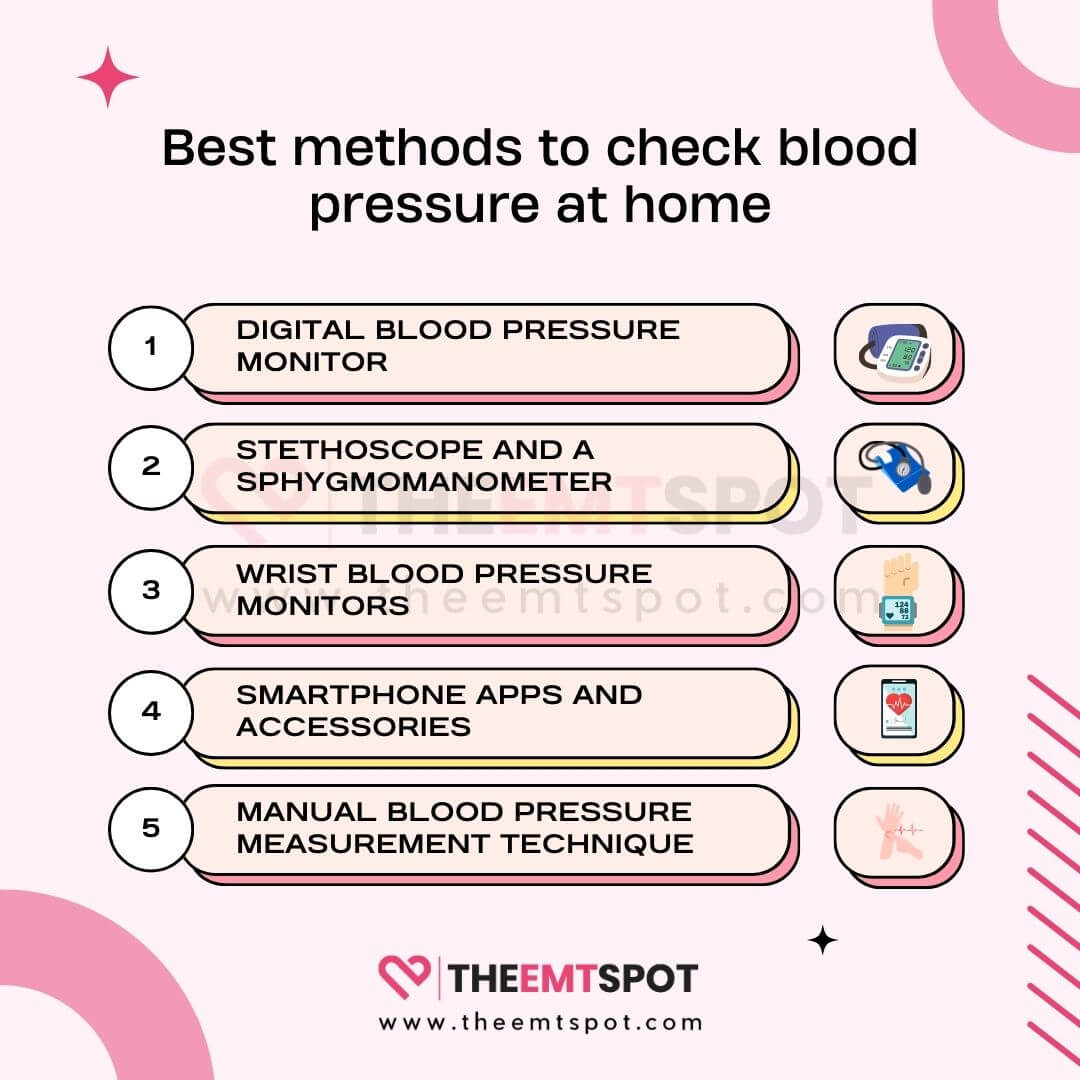
- The first option is the digital blood pressure monitor, which is widely used for its simplicity and precision. These monitors typically have an upper arm cuff and a digital screen displaying your blood pressure readings.
- Another traditional method involves using a stethoscope and a sphygmomanometer, where you inflate the cuff and listen for blood flow sounds in the brachial artery using the stethoscope, providing systolic and diastolic pressure readings.
- Wrist blood pressure monitors, similar to digital arm monitors but worn on the wrist, offer convenience but may not be as accurate and require proper positioning.
- Smartphone apps and accessories can also measure blood pressure using the phone’s sensors or external devices, though they may not always provide medical-grade accuracy.
- Lastly, one of manual blood pressure measurement technique without a stethoscope is possible but less accurate, involving feeling for the radial artery pulse while inflating and deflating the cuff, making it an option that requires some experience.
Achieving a completely instrument-free measurement of blood pressure remains unattainable due to the inherent complexities of the physiological processes involved.
Instead, the diagnostic approach predominantly relies on symptom correlation, which, though informative, falls significantly short in terms of accuracy and effectiveness in providing precise blood pressure readings.
To ensure that you are measuring it correctly, make sure you have the right type of blood pressure monitor. The following section will help you understand all types of blood pressure monitors.
What types of blood pressure monitors are available?
Different types of blood pressure monitors are designed with a focus on convenience, ease of use, and accuracy. Below are various types of blood pressure monitors that you might encounter.
Upper arm monitors
- These are the most common and widely recommended type. They consist of a cuff that wraps around the upper arm and inflates to measure blood pressure.
- They are known for providing the most accurate readings, especially when used correctly.
Wrist monitors
- These are smaller, more portable devices that fit around the wrist.
- While convenient, they are generally less accurate than upper arm monitors. Their accuracy can be affected by the position of the wrist relative to the heart.
Finger monitors
- These fit over a finger to measure blood pressure.
- They are the least common and are considered the least accurate of the three types. Their readings can be significantly affected by temperature and the position of the hand.
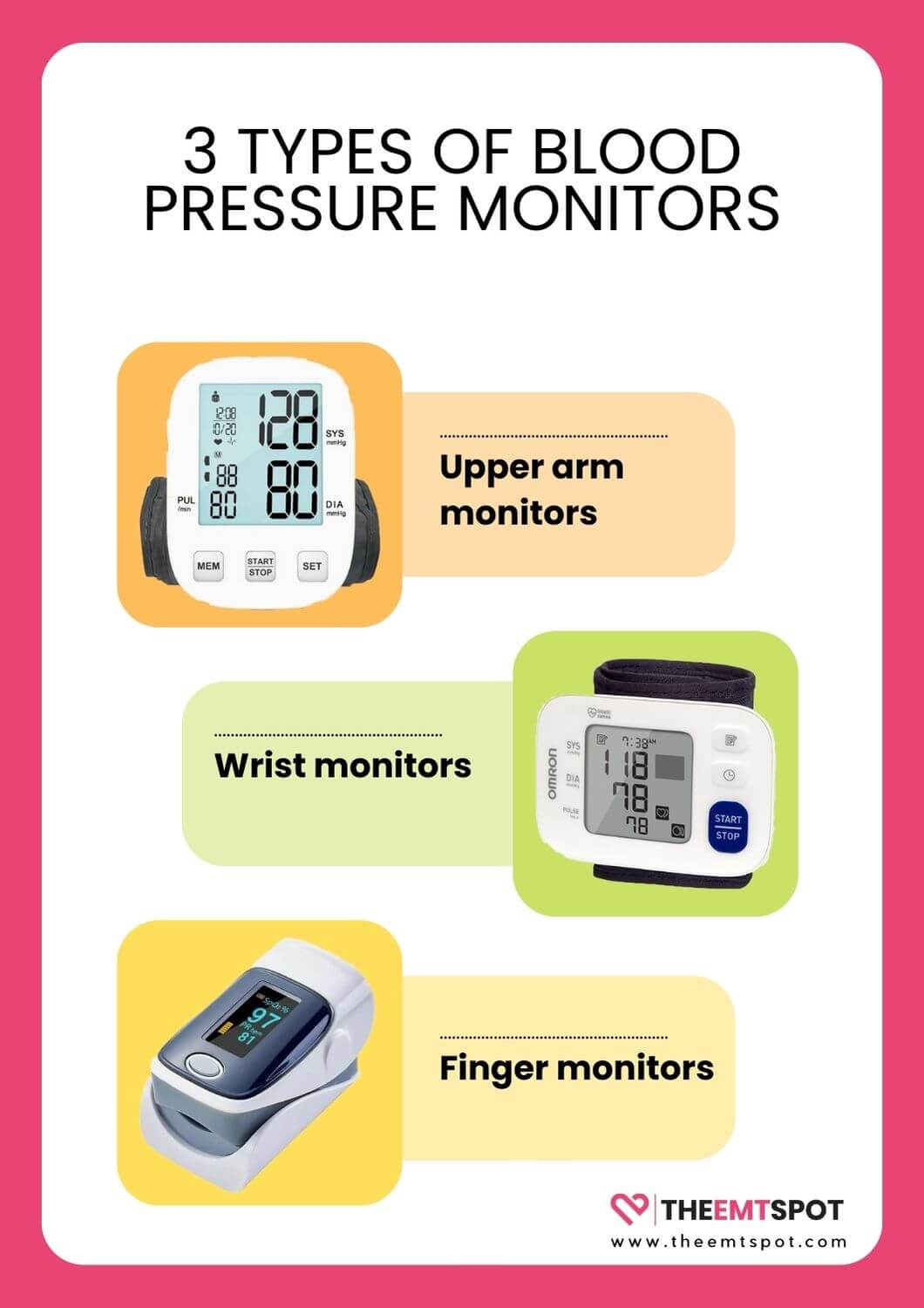
For precision and reliability, as recommended by the American Heart Association (AHA), upper arm blood pressure monitors stand out as the preeminent choice.
They are the preferred choice of blood pressure monitors among doctors, hospitals, and self-monitoring individuals due to their clinically validated results.
Dr. Jacob George and Dr. Thomas M. MacDonald, in a 2015 article published in the European Cardiology Review, also suggest that ambulatory measurement of blood pressure using an upper arm monitor provides the most accurate estimation of a person’s blood pressure.
Not all of these may be suitable for home use, and there is a separate list of products specifically designed for home use. Below, you will learn more about them.
Which blood pressure monitor is best for home use?
What are the best blood pressure monitors? This might be one of the most important questions when it comes to blood pressure measurement.
Typically, there will be a long list of products to consider. However, after a thorough review of existing products, two of the most high-performing brands are Oxiline and CheckMe.
Oxiline’s Pressure X Pro is their top-of-the-line product, while CheckMe’s BP2 is the standout choice for the brand.
Below is a side-by-side comparison of their features to help you understand these products better.
Oxiline | CheckMe |
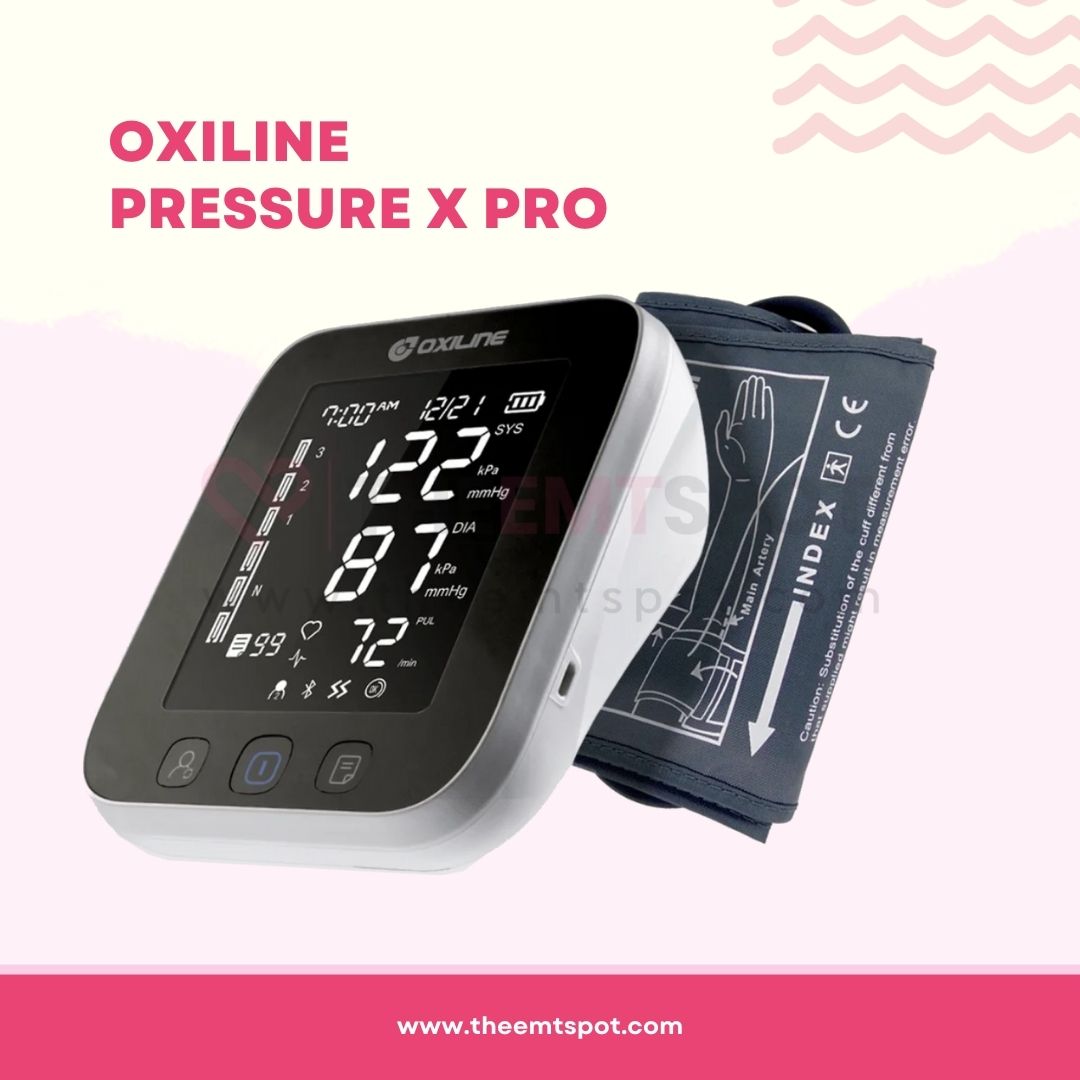 |  |
Type Cuffed with tube | Type Cuffed tubeless |
Smart feature(s) FDA 510 (k) Granted. Mobile App Support. VIBRA™ TX Sensor for detecting arterial pressure. Bluetooth connectivity. Lifetime warranty. | Smart feature(s) Mobile App Support. ECG with AI analysis. Wi-Fi and Bluetooth connectivity. Rechargeable. OLED screen. Real-time Tracking. |
Number of users Multi-User Suport via App | Number of users Multi-User Suport via App |
Number of readings per user 120 readings on the device. Unlimited App storage. | Number of readings per user 50 BP Readings on the device. 10 EKG readings on the device. Unlimited App storage. |
Weight 453 g | Weight 240 g |
Oxiline is undoubtedly the most reliable product out there. They have FDA 510(k) approval, and their smart Bluetooth connectivity makes it a cutting-edge product as well.
In fact, many clinicians recommend this product for accurate blood pressure measurement at home.
On the other hand, CheckMe BP2 excels with its lightweight build and smartphone connectivity feature.
Unlike other models, it is sleek and doesn’t have a cuff, making it an ultra-portable blood pressure measuring tool with clinical precision.
Some of the other models you may consider include Withings BPM Connect, Omron Silver, and QardiArm.
Having a blood pressure monitor is only half of the task; calibrating it for accurate readings is very important.
How do you calibrate a blood pressure monitor?
Calibrating a blood pressure monitor typically involves comparing and adjusting its readings to match those of a known accurate device, usually in a healthcare setting.
According to Dr. Margret Collins Hill from Wilmington, North Carolina, from eHowHealth:
“ The accuracy of blood pressure machines is very important because a small difference in readings makes a difference in what medications may be adjusted.”
She added:
“I’d rather prefer a home BP machine that reads consistent with clinic one. It is okay to have a machine that reads 10 points high all the time rather than one that reads perfect but inconsistent.”
Below is a general overview of Dr. Hills’ recommendations for calibrating your blood pressure monitor.
- Professional check-up: It’s usually recommended to take your blood pressure monitor to a healthcare provider. They can compare its readings against a calibrated, professional-grade device.
- Simultaneous measurements: The healthcare provider will take blood pressure measurements with both the professional device and your personal monitor to see if there’s a discrepancy.
- Adjustments: If there’s a significant difference between the two readings, the monitor may need to be calibrated. Some digital monitors have an automatic calibration feature, while others might require manual adjustments or servicing by the manufacturer.
- Regular checks: It’s recommended to have your monitor checked and calibrated (if needed) every year or as advised by your healthcare provider.
- Consult the manual: Always refer to the user manual of your specific model for instructions and recommendations about calibration.
While the accuracy of readings is primarily attributed to the technology of the device, its proper calibration, and the method of measurement, errors can still occur if preparation is not done correctly.
Below, you will learn how to correctly prepare yourself for taking blood pressure readings.
How should you prepare before taking your blood pressure?
Preparing yourself before taking your blood pressure is important to ensure accurate results, regardless of the type of instrument you use.
In a clinic or hospital, the personnel taking your blood pressure are well-trained in these fundamentals, which is why they instruct you to sit upright and position your hands in a specific elevated manner, among other things.
According to a 2023 article published in Harvard Health, reviewed by Dr. Howard E. LeWine, MD, poor preparation for measuring blood pressure could lead to a variation of up to 10% in your reading, which, in clinical terms, constitutes a significant error.
Below are some points from Dr. LeWine’s article that will help you measure your blood pressure correctly at home.
- Rest for a few minutes: Sit quietly and relax for at least 5 minutes before taking your blood pressure. Avoid any strenuous activities or exercise immediately beforehand, as this can temporarily raise your blood pressure.
- Empty your bladder: A full bladder can affect your blood pressure reading, so it’s a good idea to use the restroom before measuring your blood pressure.
- Choose the right time: Try to take your blood pressure at a consistent time each day, as it can fluctuate throughout the day. Many people find it helpful to measure their blood pressure in the morning before eating or taking medications.
- Wear appropriate clothing: Make sure your clothing is loose-fitting and does not constrict your arm, as a tight dress can affect the accuracy of the measurement. It’s also a good idea to roll up your sleeve if it’s long.
- Avoid caffeine and nicotine: Both caffeine and nicotine can temporarily raise your blood.
- Sit upright during reading: When taking your blood pressure, it’s essential to maintain an upright sitting position with your back straight and feet flat on the floor.
- Try not to hold your breath: While the blood pressure cuff is inflating or deflating, avoid keeping your breath or taking deep breaths. Holding your breath can temporarily raise your blood pressure, leading to inaccurate readings.
- Loosen your arm: Ensure that your arm is relaxed and not constricted by tight clothing or muscle tension. A loose arm allows the blood pressure cuff to fit properly and provides accurate readings.
As mentioned earlier, choosing a consistent time is crucial, but when is the perfect time? Does it vary from person to person? Let’s find out.
When is the best time to measure blood pressure?
Determining the best time to measure blood pressure (BP) can be crucial for accurate readings.
According to the Mayo Clinic, measuring blood pressure at least twice daily, ideally in the morning before eating or taking medications and again in the evening, is recommended.
Each measurement should be repeated two or three times to ensure consistency. Blood pressure varies throughout the day and is typically higher in the morning.
According to Dr. Gaurang Gujarathi, DO, a cardiologist with AMITA Health in Bourbonnais, IL:
“It’s often recommended to measure blood pressure throughout the day, as blood pressure keeps changing based on stress levels and other factors.”
He added:
“I ask my patients to check it once or twice, but not more than that, as frequent checking might indicate it as high.”
“How you monitor blood pressure is also important. The tightness of the cuff and the location of the cuff can often lead to pseudo hypertension, meaning abnormally high blood pressure,” added Dr. Gaurang.
Another tip is to relax before measurement to ensure that anxiety does not influence the results. You will learn more below.
How can you relax before taking your blood pressure?
Relaxing before blood pressure measurement is one of the most important things to ensure accurate results.
People who are anxious or stressed about blood pressure measurement can experience skewed readings, as these readings are directly proportional to stress levels.
This is why relaxation techniques are so important; they can help normalize your heart rate and assist in relaxing your blood vessels, leading to more accurate blood pressure readings.
- Mindfulness and meditation: Meditation can significantly calm your mind and reduce stress, which may lower blood pressure. Regular meditation, even for short periods like five minutes, focusing on your breathing, can positively impact blood pressure readings.
- Avoiding stimulants: Consuming caffeine can cause a temporary spike in blood pressure. It’s advisable to avoid coffee, tea, chocolate, and other caffeinated foods and drinks a few hours before taking your blood pressure.
- Spending time with pets: Interacting with pets, such as giving a dog belly rubs, can lower blood pressure. This relaxation technique can be especially beneficial before measuring blood pressure.
- Dietary considerations: Avoiding salty foods is important as high sodium intake can increase blood pressure. Opting for low-sodium meals and avoiding pre-packaged, processed, and restaurant foods can prevent blood pressure spikes.
- Physical comfort: Ensuring physical comfort before taking blood pressure is vital. For example, a full bladder can increase blood pressure, so it’s important to use the bathroom beforehand.
- Post-exercise waiting period: Blood pressure increases during exercise and takes some time to return to normal levels. Therefore, it’s recommended to wait a couple of hours after exercising before measuring blood pressure.
- Alcohol consumption: Consuming alcohol can increase your blood pressure. It’s advised to avoid alcohol consumption before taking a blood pressure reading.
- Proper sitting posture: The position in which blood pressure is measured can affect the readings. Sitting in a comfortable chair with feet flat on the floor and back straight and supported is
A study from National Taiwan University by Dr. L L Yen et al. provides further evidence of the effectiveness of relaxation techniques.
The study included 590 individuals with hypertension who were divided into three groups: one group received training in relaxation techniques to practice at home, another underwent regular blood pressure monitoring by a healthcare professional, and the third group was provided with self-learning materials.
Examining the two-month intervention, participants who practiced relaxation techniques experienced a notable decrease in their systolic blood pressure.
Additionally, reviews of several studies underscore the potential benefits of slow breathing exercises and relaxation therapies in modestly reducing blood pressure, although these studies had limitations like short follow-up periods and varying methodologies.
Incorporating these relaxation techniques can contribute significantly to obtaining accurate blood pressure readings and managing hypertension effectively.
Adding more validity to the measurement is the resting period before starting the measurement. The next section will give you a better idea.
How long should you wait after taking blood pressure medication to check your blood pressure?
The general recommendation to wait 3 to 5 minutes after taking blood pressure medication before measuring blood pressure lacks substantial medical evidence.
A 2017 study in a Nature journal by Prof. Guillaume Mahe from Université de Rennes suggests that this commonly recommended resting time might be inadequate.
The study found that waiting at least 25 minutes after taking medication is necessary to obtain a valid result.
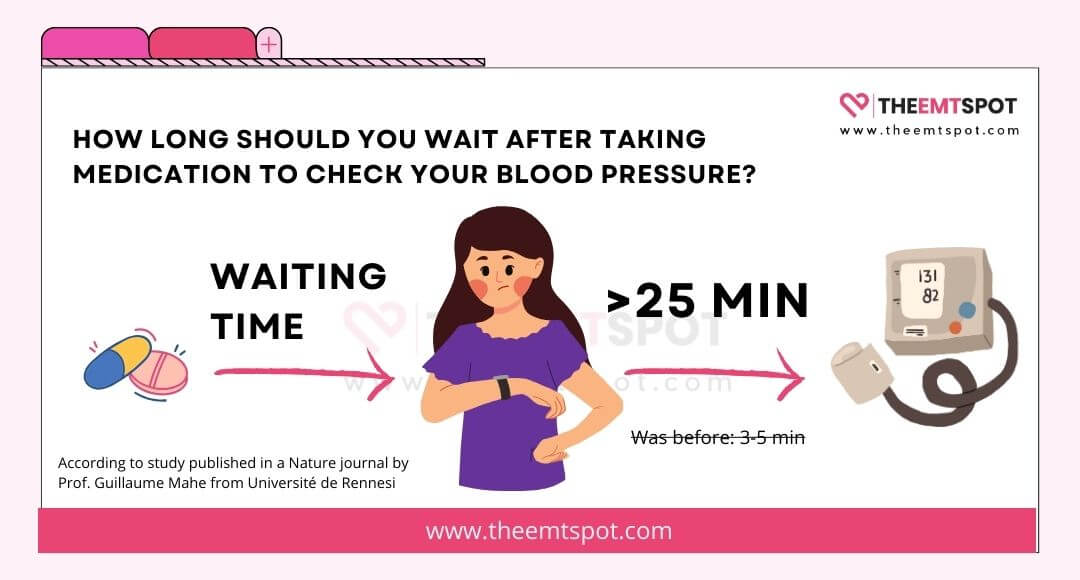
Modern medicines interact with the human body differently, and the time for stabilization can vary among individuals.
This discrepancy between standard guidelines and the study’s findings highlights the risk of misdiagnosing hypertension in routine clinical practice.
The extended waiting period is crucial to prevent overdiagnosis of hypertension.
While this is a significant recommendation, other guidelines should also be followed for accurate blood pressure measurement. Let us check those.
How can you take blood pressure accurately?
To take blood pressure accurately the Centers for Disease Control and Prevention (CDC) advises the following steps.
- Avoid consuming any food or beverages for 30 minutes prior to measuring your blood pressure.
- Empty your bladder before taking the measurement.
- Sit comfortably with back support in a chair for at least five minutes before the measurement.
- Place both of your feet flat on the floor without crossing your legs.
- Position your arm on a table so the cuff is level with your chest.
- Ensure the cuff is tight enough to stay in place but not so tight that it’s uncomfortable, and it should be directly on your skin, not over clothes.
- Remain silent during the blood pressure measurement process.
Additionally, a scientific statement from the AHA highlights the importance of using validated oscillometric devices for accurate blood pressure measurement in an office setting.
These devices reduce human errors associated with the auscultatory (listening) method and can take multiple readings even without an observer present.
Ambulatory blood pressure monitoring, which records blood pressure at regular intervals over 24 hours, is considered the reference standard for assessing blood pressure outside the office.
This method is particularly useful in diagnosing conditions like white-coat hypertension (elevated blood pressure levels only in the office setting) or masked hypertension (elevated levels outside the office but not in the office).
High nighttime blood pressure recorded during ambulatory monitoring is associated with an increased risk of cardiovascular disease.
It’s crucial that both oscillometric and auscultatory methods, when used, are performed by trained technicians using validated and calibrated devices.
The next section will provide a clearer understanding of the optimal position for measuring blood pressure.
What is the best position for taking blood pressure?
A notable study regarding posture is “The effect of different body positions on blood pressure,” published in the Journal of Clinical Nursing by Dr. Ismet Eser and colleagues.
According to this study, the optimal position for taking blood pressure is sitting comfortably with your back supported and feet flat on the ground.
It’s important to ensure that the arm is at heart level, supported on a flat surface like a table. This posture helps in obtaining the most accurate reading.
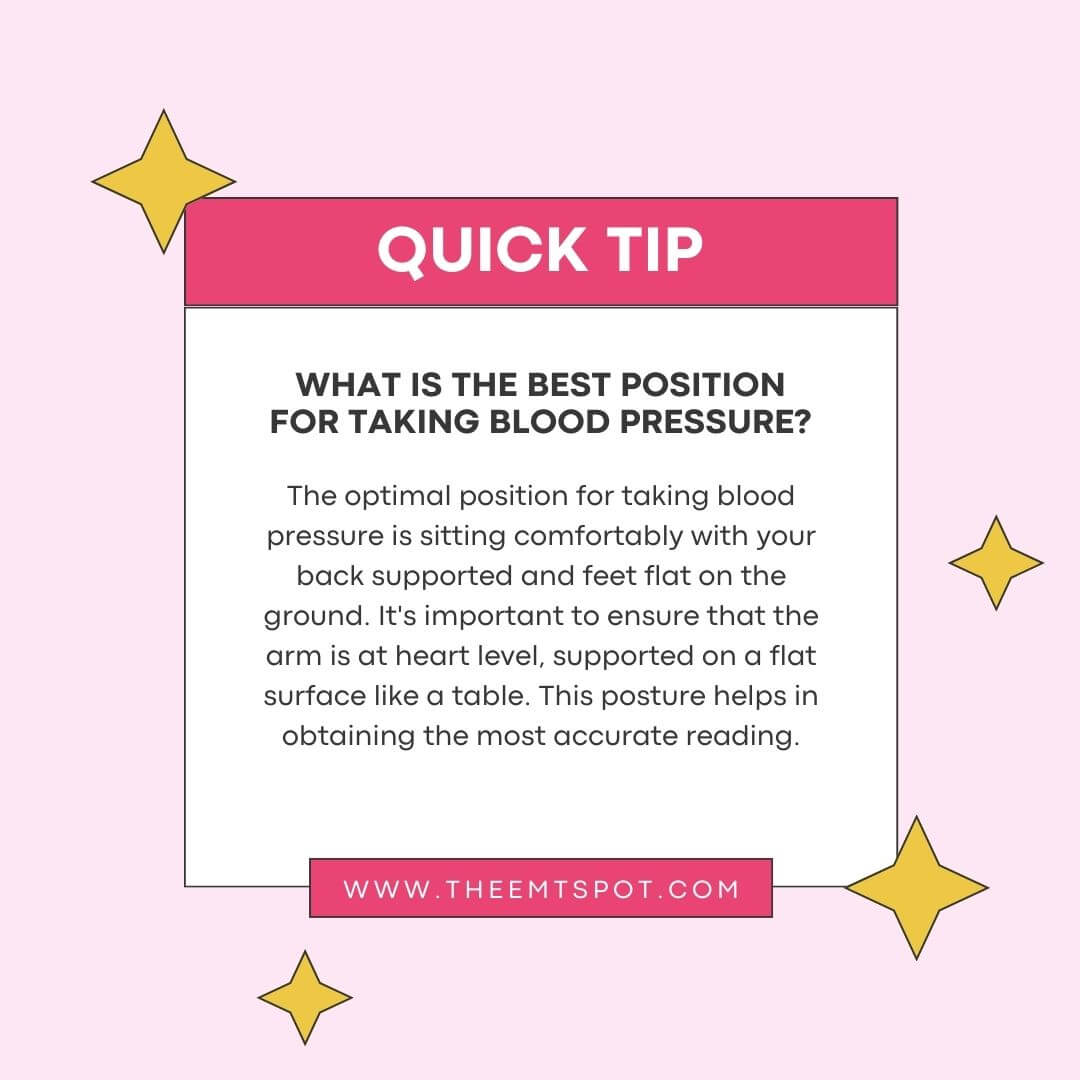
It is recommended to avoid talking or moving during the measurement and to rest for a few minutes before taking the blood pressure.
These guidelines align with the practices advocated by all major health organizations & hospitals for consistent and accurate blood pressure monitoring.
Can you measure blood pressure while lying down if that is the case? You will learn about it in the next section.
Can you measure blood pressure while lying down?
Yes, you can measure blood pressure while lying down, but it’s important to be aware of the variations in readings that can occur due to body positioning.
When lying down, make sure your arm is level with your heart for an accurate measurement, with your back supported and legs uncrossed.
Blood pressure readings can differ slightly in this position, often being marginally lower than when sitting or standing.
Recent research indicates that measuring blood pressure while lying down can offer valuable insights into aspects of heart health that differ from those obtained when measuring in a sitting position.
According to Dr. Stephen Juraschek’s publication in the Hypertension Scientific Sessions, readings taken while a person is lying down may be more predictive of stroke, serious heart problems, and death compared to readings taken while seated.
While position is critical, proper usage of a blood pressure monitor while measuring might decide whether you are getting false data. The following sections explain more about it.
How do you put on a blood pressure cuff?
To put on a blood pressure cuff to get proper readings, you need to have the right technique.
A research article in the Journal of Clinical Hypertension advises that the cuff should encircle the upper arm with its central inflatable section (the bladder) aligned over the brachial artery for accurate blood pressure measurements.
Once the cuff is in place, relax your arm and avoid talking or moving during the measurement.
It’s important to follow the instructions provided with your specific blood pressure monitor, as slight variations may exist between different models.\
A general guideline to put your blood pressure cuff is given below.
- Begin by sitting comfortably with your back supported and legs uncrossed.
- Place your arm on a flat surface, ensuring it’s at heart level.
- Roll up your sleeve so that the cuff can be placed on your bare arm.
- The cuff should be snug but not too tight; you should be able to slide one fingertip under it.
- Position the cuff so that the lower edge is about an inch above the bend of your elbow.
- Blood pressure cuffs come in various sizes to ensure accurate measurements for different arm circumferences. Make sure you have the right cuff size. The most common sizes are small, medium, large, and extra-large. Small cuffs are typically used for children or individuals with slender arms, while medium cuffs are suitable for average-sized adults.
- Ensure that the tubing is positioned over the front center of your arm, allowing for the accurate placement of the sensor.
Below, you will discover the appropriate level of tightness needed to ensure accurate blood pressure readings.
How tight should the blood pressure cuff be?
The tightness of a blood pressure cuff should be akin to a firm handshake. It needs to be snug around your arm but not excessively tight, akin to fastening a watch strap that’s secure yet comfortable. This appropriate level of tightness is crucial for accurate readings.
Dr. T. E. Banner published an article in the Journal of Clinical Monitoring, highlighting the effects of cuff snugness on blood pressure readings.
According to him, it is important to note that using a cuff that is too small for your arm, even if wrapped snugly, can lead to inaccurately high blood pressure readings, often by around 10 mmHg on average.
Conversely, loosely wrapping a small cuff can produce highly variable and often exaggerated systolic blood pressure readings, ranging from 2 to 80 mmHg.
In contrast, when using a cuff of the right size, loose wrapping around areas like the ankles does not significantly affect blood pressure readings.
This highlights that the issue lies more with incorrect cuff size and wrapping tightness rather than the location of measurement.
But is it true that cuff snugness might be a bit tricky for pregnant women? Read more about blood pressure monitoring and cuff snugness in pregnant women below.
Can you use a blood pressure monitor during pregnancy?
Using a blood pressure monitor during pregnancy is not only safe but also essential for monitoring the health of both the mother and the unborn child.
During pregnancy, a woman’s body undergoes significant changes, including fluctuations in blood pressure, which can be an indicator of various health conditions.
Regular monitoring can help detect conditions like gestational hypertension or preeclampsia, which are characterized by elevated blood pressure and can pose risks if left unmanaged.
When using a blood pressure monitor during pregnancy, it’s crucial to use a properly sized cuff. A cuff that’s too tight or too loose can give inaccurate readings.
It’s often recommended to use an upper arm monitor rather than a wrist monitor for better accuracy.
The position during measurement is also important; sitting with the back supported, feet flat on the ground, and the arm at heart level can help get consistent and reliable readings.
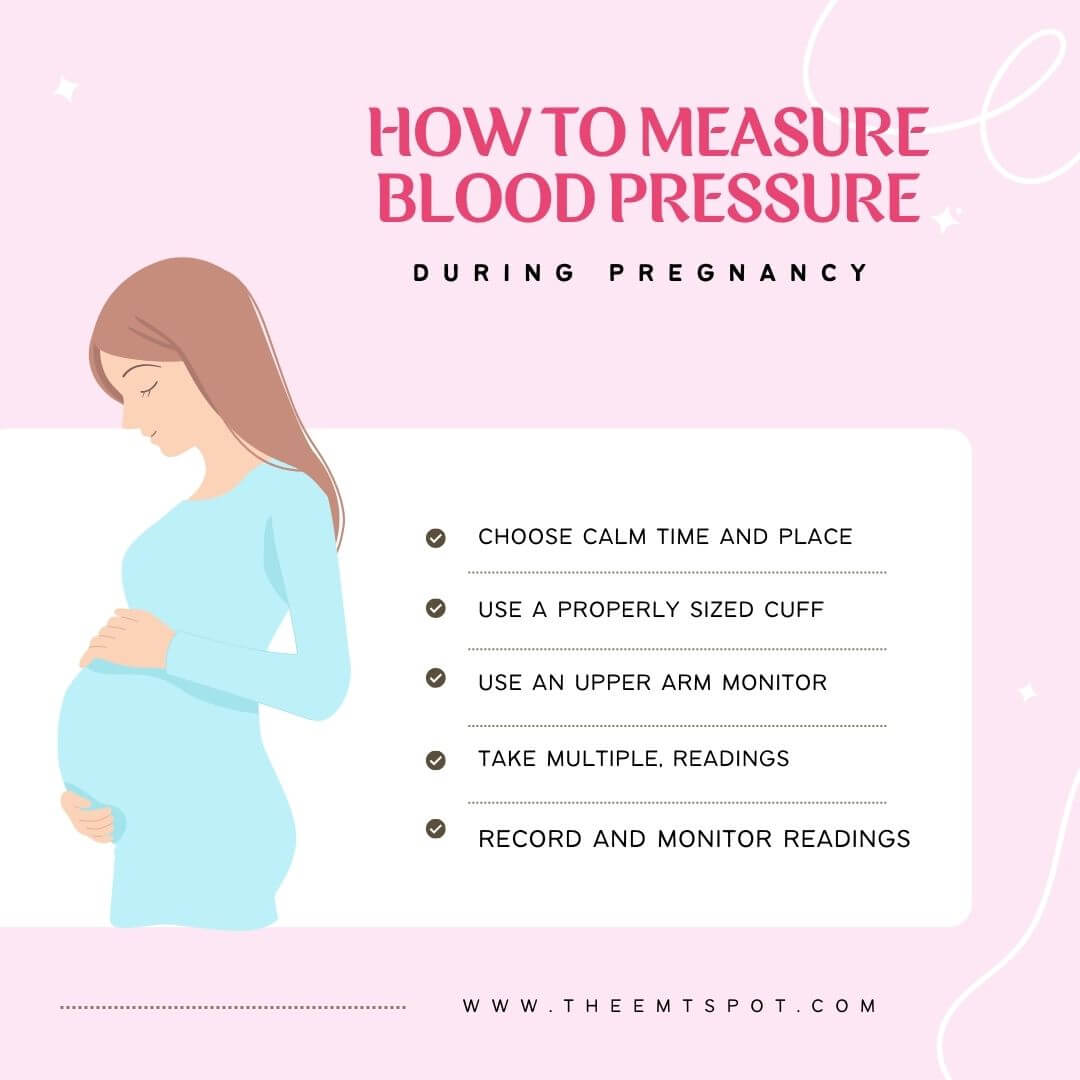
Consulting your obstetrician about how often to check blood pressure is important, as they may have specific recommendations based on individual health needs.
They can also provide guidance on interpreting the readings and what actions to take if there are any concerns.
Consistently monitoring blood pressure is an uncomplicated but highly effective method to oversee maternal well-being and swiftly respond to any health concerns that may emerge during pregnancy.
This frequent monitoring might come in handy for females suffering from preeclampsia, and you will learn more about it below.
How often should you check your blood pressure if you have preeclampsia?
The frequency of blood pressure checks for pregnant women with preeclampsia can vary based on the severity of the condition, gestational age, and individual health circumstances.
According to a publication in STATPearls by Dr. Shahd A. Karrar and Dr. Peter L. Hong, maternal deaths range from 9% to 26% in low-income countries, while the rate is around 16% in developed countries, highlighting the prevalence.
In mild cases of preeclampsia, healthcare providers usually recommend more frequent prenatal visits, typically once or twice a week, to monitor blood pressure and other vital signs.
These visits often include blood pressure measurements, urine tests to check protein levels (a sign of kidney involvement), and possibly blood tests to evaluate liver function and platelet count.
Regular ultrasounds may also be performed to monitor the baby’s growth and amniotic fluid levels.
For more severe cases of preeclampsia, which may present greater risks to both the mother and the baby, closer monitoring is necessary. This could involve hospitalization, where blood pressure is often checked every few hours.
Continuous fetal monitoring may also be required to ensure the baby’s well-being. In addition to professional medical monitoring, self-monitoring at home can be an important part of managing preeclampsia.
Patients may be advised to check their blood pressure daily or even more frequently, depending on the severity of their condition and the doctor’s recommendations.
Note that home monitoring should always be done in conjunction with regular medical appointments, not as a substitute.
Regularly checking blood pressure is essential for those with preeclampsia, a condition in pregnancy marked by elevated blood pressure and potential harm to other organs, frequently affecting the kidneys.
Which arm should you use to take blood pressure?
The left arm is primarily used in a clinical setup to measure your blood pressure. However, modern practice necessitates taking readings from both hands.
It’s important to note that blood pressure can vary between the left and right arms, and sometimes this difference can be significant.
According to a 2019 AHA study published in the journal Hypertension, you must determine the arm that gives you a higher reading and use the same for subsequent measurements from then on.
While checking your blood pressure at home, if you’re unsure which arm to use, it’s advisable to consult with your doctor.
In another publication titled “Comparison between Right and Left Upper Arms in Detection of Hypertension” by Dr. Bo Mi Song et al., it is necessary to check blood pressure in both arms.
Also mentioned in the study, if double-arm measurements are unavailable, the right arm is preferred for measuring blood pressure, especially in the case of women.
This contradicts the conventional practice of using the left arm, but it is worth noting that this study is conducted on a Korean population, and the results might only be significant for them.
Clinically, it is advised to go by the AHA recommendation to determine the arm with higher readings and follow it from then on.
While all these subheadings have helped you learn how to measure blood pressure using an electronic blood pressure monitor, what will you do when you don’t have access to one?
How can you check your blood pressure without a monitor?
Checking your blood pressure without a monitor, also known as a sphygmomanometer, isn’t possible in the traditional sense.
Blood pressure readings require the measurement of the force of blood against your artery walls, which isn’t something you can assess accurately without the proper equipment.
There are some claims suggesting that you can rely on symptoms of high and low blood pressure to make a vague estimation of your blood pressure; however, this is never accurate.
Below are the reasons why you can’t rely on alternatives to gauge your blood pressure.
- Physical symptoms: While certain symptoms might suggest high or low blood pressure, as mentioned earlier, they are not reliable for a diagnosis. Many of these symptoms can be caused by a variety of other health issues.
- Pulse rate: Some people mistakenly think that checking the pulse rate can indicate blood pressure, but this is not true. Pulse rate (how fast your heart is beating) and blood pressure (how much force is exerted on your arteries) are different measurements, and one cannot accurately infer the other.
- Listening to the heart: Even healthcare professionals cannot determine blood pressure by simply listening to the heart with a stethoscope. They need a blood pressure cuff and stethoscope to measure it properly.
- Digital health applications: There are mobile apps claiming to measure blood pressure, but these are not considered reliable or accurate by medical standards. Most of these apps use algorithms and estimations, which are not a substitute for actual measurement.
For accurate and reliable blood pressure readings, the use of a blood pressure monitor is essential. These devices are widely available, and many are designed for easy use at home.
However, if you have access to a stethoscope and a sphygmomanometer, then you can use them to estimate your blood pressure. More details are provided below.
How do you take blood pressure with a stethoscope?
Measuring blood pressure accurately requires more than just a stethoscope; you also need a sphygmomanometer, which is a blood pressure cuff with a pressure gauge. Below are a few reasons why you cannot measure with just a stethoscope.
- Pressure Control: A stethoscope alone cannot control the pressure applied to the arm. A blood pressure cuff, which includes a pressure gauge, is necessary to inflate and deflate the cuff accurately to the appropriate level for measurement.
- Pressure Reading: A stethoscope alone cannot provide a numerical blood pressure reading. The pressure gauge on the cuff is essential for quantifying systolic and diastolic blood pressure values.
- Auscultation: Blood pressure measurement involves auscultation, which is the act of listening to specific sounds in the brachial artery with the stethoscope. These sounds help identify the systolic and diastolic pressures without a blood pressure cuff to create the necessary conditions (such as occluding the artery and gradually releasing pressure); the stethoscope alone cannot capture these critical sounds accurately.
In summary, while a stethoscope is a vital tool for auscultating blood pressure sounds, it must be used in conjunction with a blood pressure cuff and gauge to control pressure and provide numerical readings, ensuring accurate and reliable blood pressure measurement.
But if you also have a sphygmomanometer, then you can take clinically accurate readings, but it requires practice.
How do you measure blood pressure with a sphygmomanometer?
Measuring blood pressure with a sphygmomanometer involves using a cuff, a pressure bulb, and a stethoscope.
The cuff creates localized pressure on the arm, causing the brachial arteries to sense the pressure, which is measured against the mercury inside the sphygmomanometer.
The systolic and diastolic readings are confirmed with the help of a snapping sound heard through the stethoscope.
According to the article titled ‘How to Measure and Record Blood Pressure,’ published in the Community Eye Health journal, the steps to measure blood pressure with a sphygmomanometer are as follows.
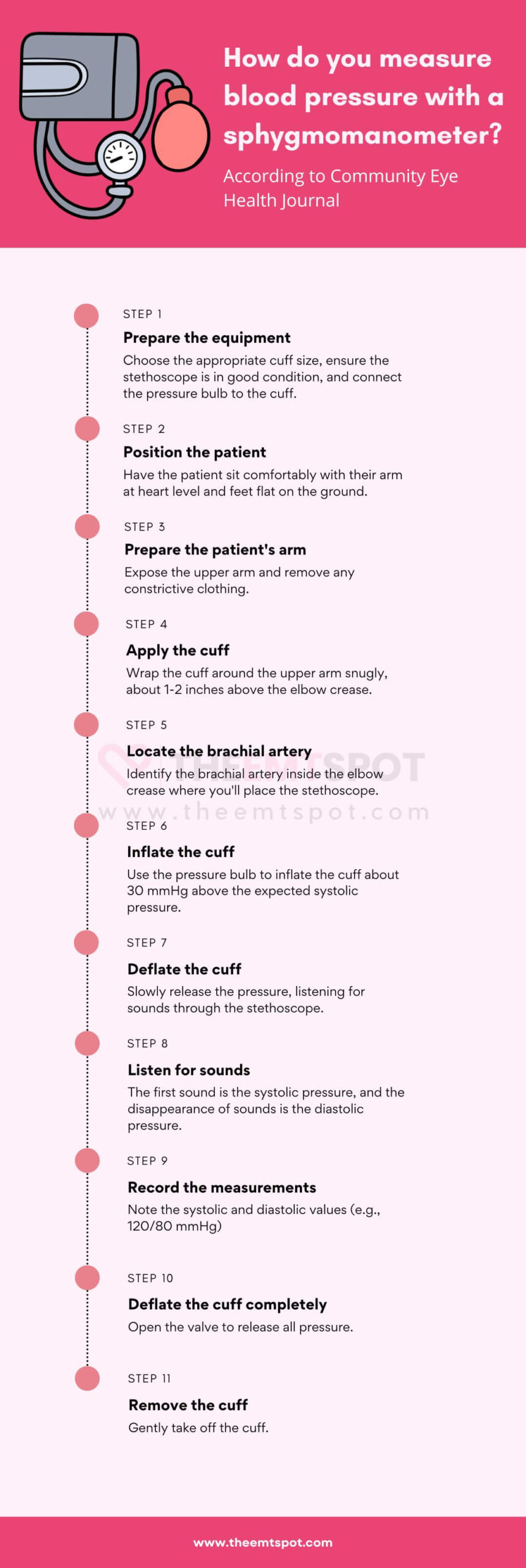
- Prepare the equipment: Choose the appropriate cuff size, ensure the stethoscope is in good condition, and connect the pressure bulb to the cuff.
- Position the patient: Have the patient sit comfortably with their arm at heart level and feet flat on the ground.
- Prepare the patient’s arm: Expose the upper arm and remove any constrictive clothing.
- Apply the cuff: Wrap the cuff around the upper arm snugly, about 1-2 inches above the elbow crease.
- Locate the brachial artery: Identify the brachial artery inside the elbow crease where you’ll place the stethoscope.
- Inflate the cuff: Use the pressure bulb to inflate the cuff about 30 mmHg above the expected systolic pressure.
- Deflate the cuff: Slowly release the pressure, listening for sounds through the stethoscope.
- Listen for sounds: The first sound is the systolic pressure, and the disappearance of sounds is the diastolic pressure.
- Record the measurements: Note the systolic and diastolic values (e.g., 120/80 mmHg).
- Deflate the cuff completely: Open the valve to release all pressure.
- Remove the cuff: Gently take off the cuff.
Ensure accuracy and proper technique by using the right cuff size and maintaining equipment. Calibrate the sphygmomanometer regularly for reliable readings.
Accuracy and proper technique are essential when measuring blood pressure with a sphygmomanometer.
But is there a manual method to measure your blood pressure? Let’s explore below.
Is there a manual method to check blood pressure?
The term manual method is used to describe blood pressure measurement using a sphygmomanometer and a stethoscope because it involves a hands-on, manually operated procedure typically performed by a trained healthcare professional.
In fact, a study by Mirdamadi et al., published in the Journal of ARYA Atherosclerosis, suggests that the manual method of measurement is more accurate in critical conditions than automatic ones.
This method is characterized by active participation, with the operator manually inflating the cuff, listening for specific sounds through the stethoscope, and recording the readings.
The manual method also involves manually controlling the inflation and deflation of the cuff using a hand-operated bulb or pump, in contrast to automated methods where the machine handles these tasks.
Moreover, the healthcare provider relies on auditory interpretation of the Korotkoff sounds, which are distinct tapping or thumping sounds heard as blood flows through the artery when the cuff’s pressure is released.
Given the skill and training required for precise execution, the term manual underscores the hands-on and expertise-dependent nature of this method, which is considered the gold standard for measurement in clinical settings due to its accuracy when performed correctly.
Despite its versatility, ambulatory measurement is considered the most secure and accurate method in a clinical setup. Below, you will learn more about it.
What is ambulatory blood pressure monitoring?
Ambulatory blood pressure monitoring (ABPM) is a method of measuring blood pressure over an extended period, usually 24 hours, while a person goes about their daily activities and sleep routines.
It provides a more comprehensive and accurate assessment of a person’s blood pressure variations throughout the day and night compared to a single measurement taken in a clinical setting. Below elaborated is the working of an ABPM.
- Wearing the monitor: The individual wears a compact, portable blood pressure monitor, which is typically worn on a belt or shoulder strap. The monitor is connected to an inflatable cuff that is placed on the upper arm.
- Automatic measurements: The ABPM device is programmed to take blood pressure readings automatically at set intervals, usually every 15 to 30 minutes during waking hours and less frequently during sleep.
- Activity and diary: Throughout the monitoring period, the person is encouraged to go about their daily activities as usual. They may also keep a journal to record activities, meals, and times when they experience symptoms like dizziness or chest pain.
- Nighttime monitoring: The ABPM device continues to measure blood pressure during sleep, providing valuable information about nocturnal blood pressure patterns.
- Data collection: Over the 24-hour period, the monitor collects a substantial amount of blood pressure data, which is stored in the device’s memory.
- Analysis: After the monitoring period is complete, a healthcare professional or specialized software analyzes the collected data to assess patterns, fluctuations, and average blood pressure levels. This analysis helps in diagnosing conditions like hypertension (high blood pressure), white coat syndrome (elevated blood pressure in a clinical setting), and nocturnal hypertension.
A review published in the Journal of Hypertension by Prof. Hodgkins from the University of Birmingham suggests that ABPM could be a promising screening criterion for hypertension, but its conclusive results can only be validated with more studies.
Ambulatory blood pressure monitoring is particularly useful in the following situations.
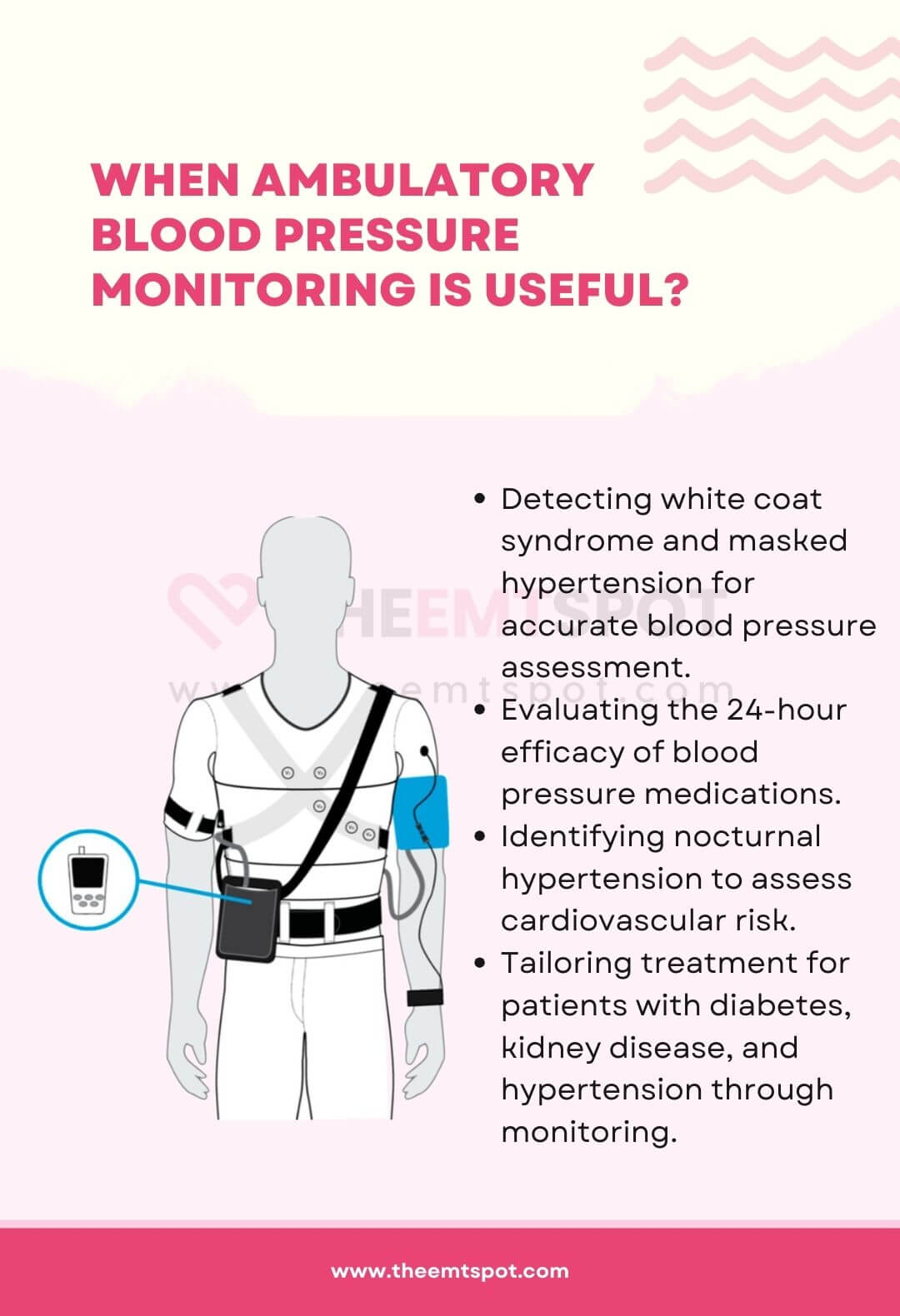
- Evaluating individuals with suspected white coat syndrome or masked hypertension, where blood pressure readings in a clinical setting do not accurately reflect a person’s true blood pressure.
- Assessing the effectiveness of blood pressure medications over a full day and night.
- Identifying nocturnal hypertension, which is associated with a higher risk of cardiovascular events.
- Monitoring blood pressure in people with conditions like diabetes, kidney disease, and high blood pressure helps tailor treatment plans more effectively.
Is there an app for measuring blood pressure?
Yes, there are apps for monitoring blood pressure, but not in a traditional sense. These apps alone cannot measure your blood pressure; instead, they connect to a monitor or a smart device to fetch the data.
The apps you might stumble upon in the Apple App Store or Google Play Store making bold claims are just bogus and inaccurate, as blood pressure measurement is an instrumentation-intensive procedure.
Some of the popular apps that can connect to a device and provide you with visualization and analysis are listed below.
App Name | Platform | Smart Features |
Blood Pressure Companion | iOS, Android | Track blood pressure, heart rate, weight, MAP calculation, reminders, statistics, export options, Touch ID support, data sharing |
Cardio Journal | iOS, Android | Easy data entry, reminders, graphs, data analysis, freeware without ads |
Welltory | iOS, Android | Stress & energy level measurement, lifestyle impact analysis, health tips, data collection from various apps and gadgets, heart rate monitor compatibility |
Blood Pressure Monitor | iOS | Comprehensive health data tracking, medication correlation, data visualization, cloud data synchronization, reminders, export options |
SmartBP | iOS | Track bp, pulse rate, weight, ECG readings, data sharing, Apple Health integration, reminders, data analysis, cloud backup, multi-user support |
Samsung Health App | iOS, Android | Sleep tracking and coaching based on sleep patterns, workout analysis for performance enhancement and injury prevention, body composition tracking with targets for weight, body fat, and skeletal muscle, sleep score based on sleep time and stages, body movement, continuous blood oxygen monitoring during sleep, snore detection recording sleep sounds, body composition measurement through Galaxy Watch |
MedM BP | iOS, Android | Compatible with numerous Bluetooth-enabled blood pressure monitors, user-friendly tool for blood pressure management, easy pairing, reliable data transfer, multiple user support, threshold settings, syncing with Apple Health and Google Fit, manual data entry, trend analysis tools, option for offline or cloud storage of data. |
Apple Health | iOS | Central and secure place for health information including records, medications, labs, activity, and sleep, data collection from iPhone, iPad, Apple Watch, and third-party devices, encrypted data for privacy protection, machine learning for personalized insights, interactive charts and advanced trend analysis for health metrics, mental health tracking and assessments, medication logging and information, sleep management and Apple Watch sleep metrics tracking. |
Qardio Health App | iOS, Android | Centralizes health data, sets reminders, shares readings with family and doctor, allows monitoring the well-being of others who share their health measurements, operates Qardio devices and keeps health data in one convenient place. |
CheckMe App | iOS, Android | Manages employee health benefits such as health insurance, customizable insurance plans and integration of existing insurance programs, features include making doctor appointments, finding clinics, storing health test results and documents, insurance policy management, support service for immediate assistance, suitable for both insured individuals and HRs to manage health benefits. |
Now, let us see if you can measure blood pressure using some of the popular smart devices like the Apple Watch with an iPhone, Fitbit, and Samsung Galaxy Watch.
How do you check blood pressure on an iPhone and an Apple Watch?
To gauge blood pressure with an Apple Watch, it is essential to synchronize it with a connected blood pressure monitor that has undergone medical validation to ensure accuracy.
The Apple Watch itself is not equipped to measure blood pressure directly. Instead, it works in tandem with external devices, usually wireless monitors that connect to your iPhone.
One such device is the CheckMe BP2, which has been clinically tested and follows IEC80601-2-30 standards.
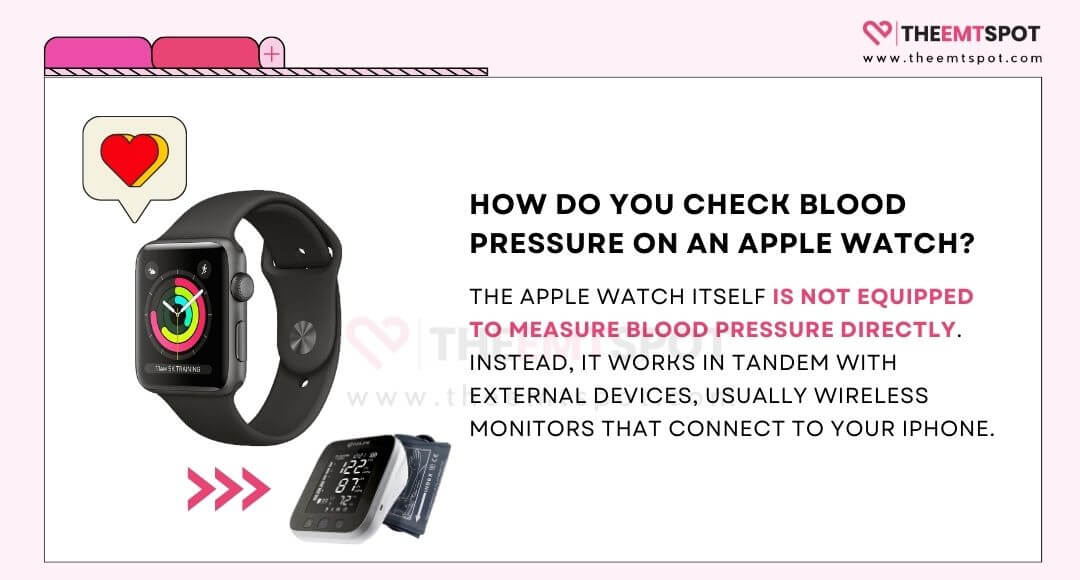
Here is the step-by-step breakdown of how to check blood pressure on the iPhone and Apple Watch.
- Setup: Begin by setting up your chosen blood pressure monitor as per the manufacturer’s instructions. Most devices will require you to download a companion app.
- Pairing: Connect the device to your iPhone using Bluetooth. For devices like the CheckMe, you might need to follow additional steps to pair it with your Apple Watch.
- Taking a reading: Once paired, taking a reading is usually as simple as wearing the monitor and starting the measurement via the companion app.
- Viewing on Apple devices: If the device’s companion app is iOS-compatible, you can view your readings directly on your watch or iPhone. The data will be catered through the Apple Health app.
How do you check blood pressure on a Fitbit?
You cannot directly check blood pressure with Fitbit devices; however, there are third-party apps that can recognize your Fitbit device to share the blood pressure data.
Apart from blood pressure, Fitbit devices can track various health metrics such as heart rate, steps, and sleep patterns.
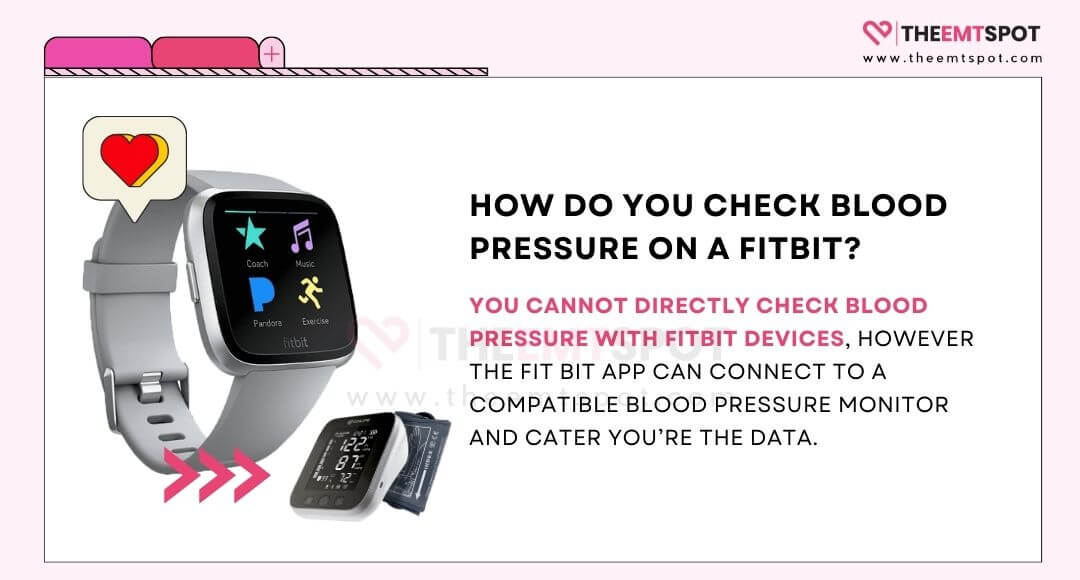
On a positive note, Fitbit has been exploring various health monitoring technologies, and there has been interest in the potential for devices like the Fitbit Sense to measure blood pressure in the future.
The concept behind measuring blood pressure with a device like the Fitbit Sense would likely involve advanced sensor technology.
A potential approach involves the utilization of pulse transit time (PTT), which approximates blood pressure by assessing the duration it takes for the blood pressure wave to traverse between two points along the arteries.
This method would require highly sensitive sensors to detect subtle changes in blood flow and pulse.
It’s important to note that while wearable technology is rapidly advancing, measuring blood pressure accurately without a cuff (non-invasively) is challenging.
While Fitbit might be able to show your blood pressure reading through third-party integration, it cannot be used directly for measurement.
How do you check blood pressure on a Samsung Galaxy Watch?
To check blood pressure on a Samsung Galaxy Watch, you need to ensure that you have a Samsung Galaxy Watch series that offers blood pressure measurement capabilities in several of its models.
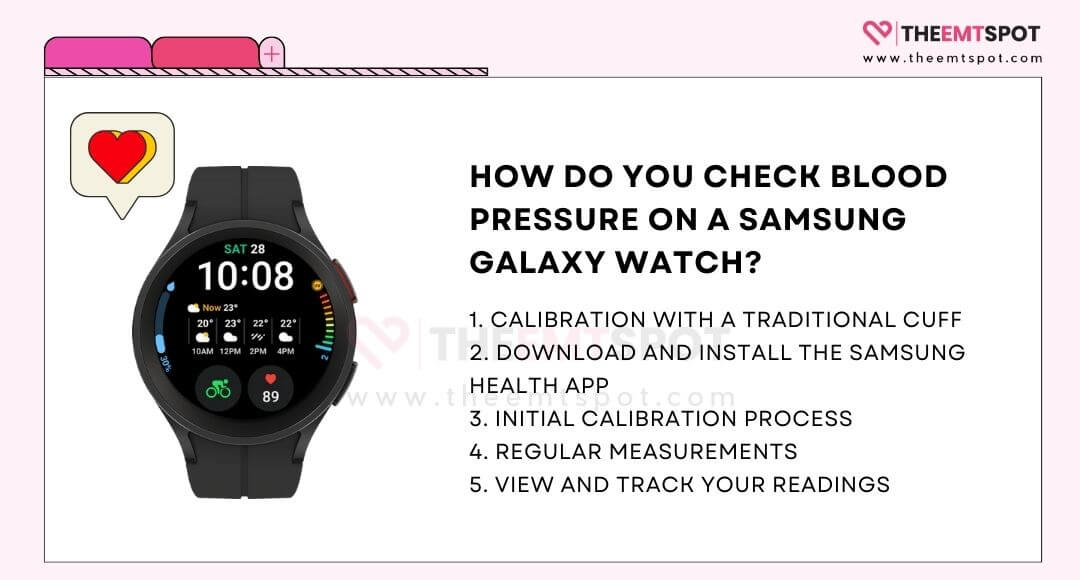
The Galaxy Watch 5 series, including the standard and Pro versions, employs pulse wave analysis technology, which is also used in its heart rate sensor, to measure blood pressure.
This feature extends to the Galaxy Watch 4 and Watch 4 Classic models as well.
Additionally, the Galaxy Watch 3 and the Galaxy Watch Active 2 are equipped with this health monitoring capability, with the Active 2 requiring pairing with the Samsung Health Monitor app for functionality.
To measure your blood pressure using a Samsung Galaxy Watch, you need to follow the steps below.
1. Calibration with a traditional cuff
Before you start using the blood pressure monitoring feature on your Galaxy Watch, it’s essential to calibrate it with a conventional cuff-based blood pressure monitor. This ensures accuracy in the readings provided by the watch.
2. Download and install the Samsung Health app
You need to have the Samsung Health Monitor app installed on both your Samsung Galaxy Watch and your connected Samsung smartphone. This app is used to record and track your blood pressure readings.
3. Initial calibration process
- Wear your traditional blood pressure cuff and start a blood pressure measurement.At the same time, open the Samsung Health Monitor app on your Galaxy Watch and follow the on-screen instructions to start the calibration process.
- Enter the blood pressure reading from your cuff into the app when prompted.
4. Regular measurements
- After the initial setup and calibration, you can measure your blood pressure using just your Galaxy Watch.
- Open the Samsung Health Monitor app on your watch.
- Sit comfortably and keep your arm still during the measurement.
- Follow the instructions on the watch screen to start the measurement.
- Wear your traditional blood pressure cuff and start a blood pressure measurement.
- At the same time, open the Samsung Health Monitor app on your Galaxy Watch and follow the on-screen instructions to start the calibration process.
- Enter the blood pressure reading from your cuff into the app when prompted.
5. View and track your readings
The app will display your blood pressure reading. You can track your readings over time within the app, which can help you and your healthcare provider monitor your blood pressure trends.
Remember, while the Samsung Galaxy Watch can provide blood pressure readings, it’s not a replacement for professional medical equipment. Always calibrate it and compare it to your conventional, clinically approved device.
What are the dangers associated with high blood pressure?
Dangers associated with high blood pressure predominantly affect our organs, such as the heart, kidneys, and brain, necessitating immediate medical attention due to the severity of hypertension.
- Heart disease and heart attacks: High blood pressure can cause the heart to work harder to pump blood, which can lead to heart disease. It also increases the risk of developing coronary artery disease, which can result in a heart attack.
- Stroke: Hypertension can lead to the weakening or damage of blood vessels in the brain, increasing the risk of a stroke. It can also cause blood clots to form in the arteries leading to the brain, blocking blood flow and potentially causing a stroke.
- Aneurysm: Elevated blood pressure has the potential to result in the weakening and expansion of blood vessels, leading to the development of an aneurysm. When an aneurysm bursts, it can pose a serious risk to one’s life.
- Heart failure: The strain placed on the heart due to elevated blood pressure can result in heart failure, a condition in which the heart becomes incapable of pumping sufficient blood to fulfill the body’s requirements.
- Kidney disease or failure: Hypertension can damage the arteries around the kidneys, affecting their ability to effectively filter blood. This can lead to kidney disease or even kidney failure.
- Vision loss: Elevated blood pressure has the potential to harm the blood vessels in the eyes, resulting in retinopathy, which can ultimately result in vision loss.
- Sexual dysfunction: This can be a side effect of high blood pressure for both men and women, as hypertension can lead to decreased blood flow.
- Peripheral artery disease (PAD): This condition, which causes narrowed arteries in the legs, arms, stomach, and head, is more common in people with high blood pressure.
- Cognitive changes: Hypertension can affect your ability to think, remember, and learn. Problems with memory or understanding concepts are more common in people with high blood pressure.
It’s important to manage high blood pressure through lifestyle changes, medication, or a combination of both, as directed by a healthcare provider.
Regular monitoring and control of blood pressure can significantly reduce the risk of these complications.
How can you lower your blood pressure naturally?
If you are still wondering how to lower your blood pressure level naturally, the answer lies in making various lifestyle changes, as supported by numerous scientific studies.
A comprehensive study published in Current Pharmaceutical Design by Jacek Rysz et al. emphasizes the importance of lifestyle modifications, including regular physical activity, dietary adjustments like reducing sodium intake and increasing potassium, weight management, and stress reduction for effective blood pressure control.
Similarly, a team of researchers from Johns Hopkins in 2012 demonstrated that a diet low in fat and carbohydrates significantly improves artery function.
They observed that weight loss, particularly around the abdomen, facilitates better artery expansion, thereby reducing blood pressure. This study underlines that a combination of weight loss and exercise is crucialfor heart health.
Moreover, the Mayo Clinic, CDC, AHA, and many health institutions outline a holistic approach involving following lifestyle changes.
- Maintaining a healthy weight
- Engaging in regular exercise
- Adhering to a healthy diet
- Reducing sodium intake
- Limiting alcohol consumption
- Quitting smoking
- Ensuring adequate sleep
- Managing stress
- Monitoring blood pressure at home
- Seeking support from friends and family
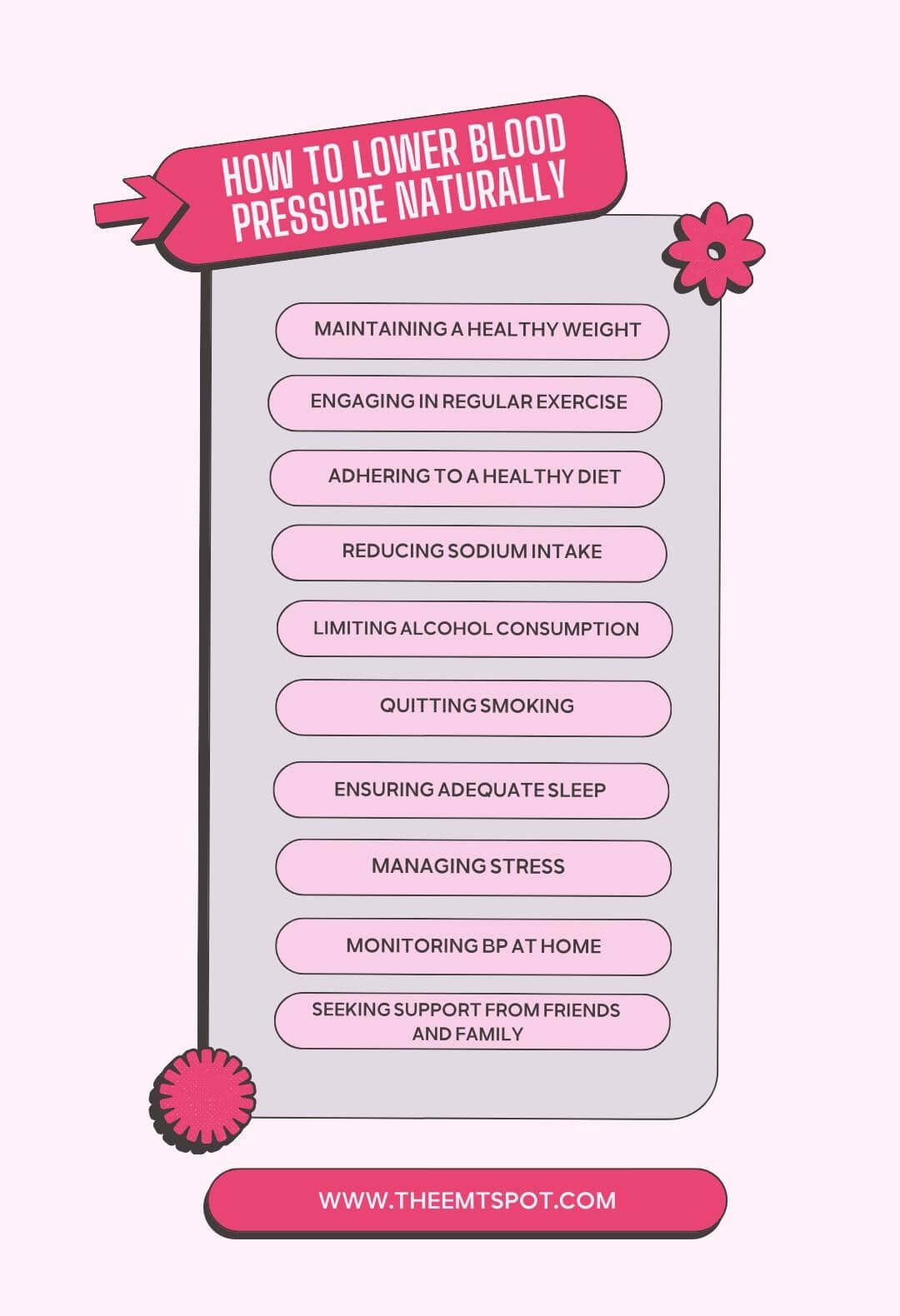
More in this topic









 Robin Backlund is a dedicated journalist and a medical student who has written several articles and essays exposing the falseness and hollowness of online resources in the medical science niche.
Robin Backlund is a dedicated journalist and a medical student who has written several articles and essays exposing the falseness and hollowness of online resources in the medical science niche.